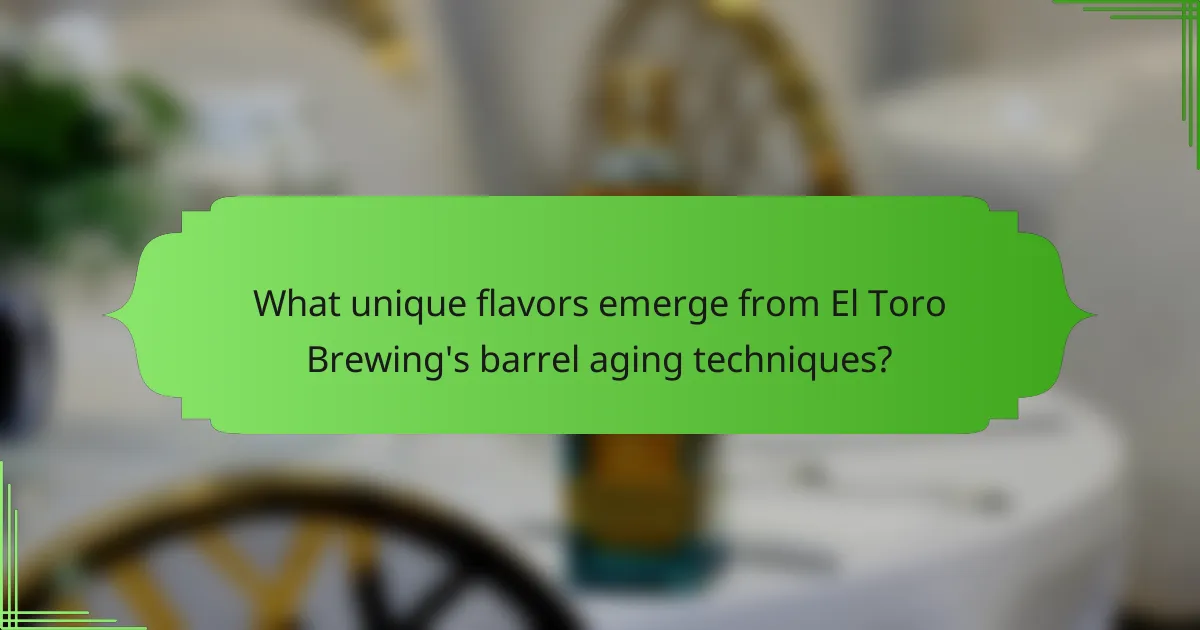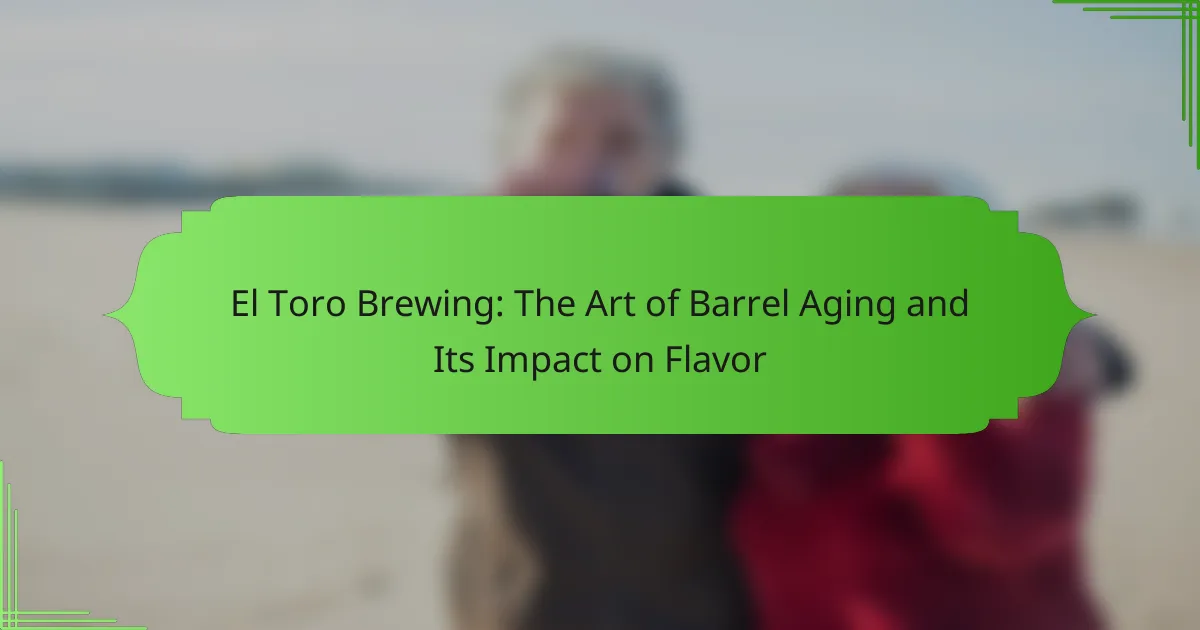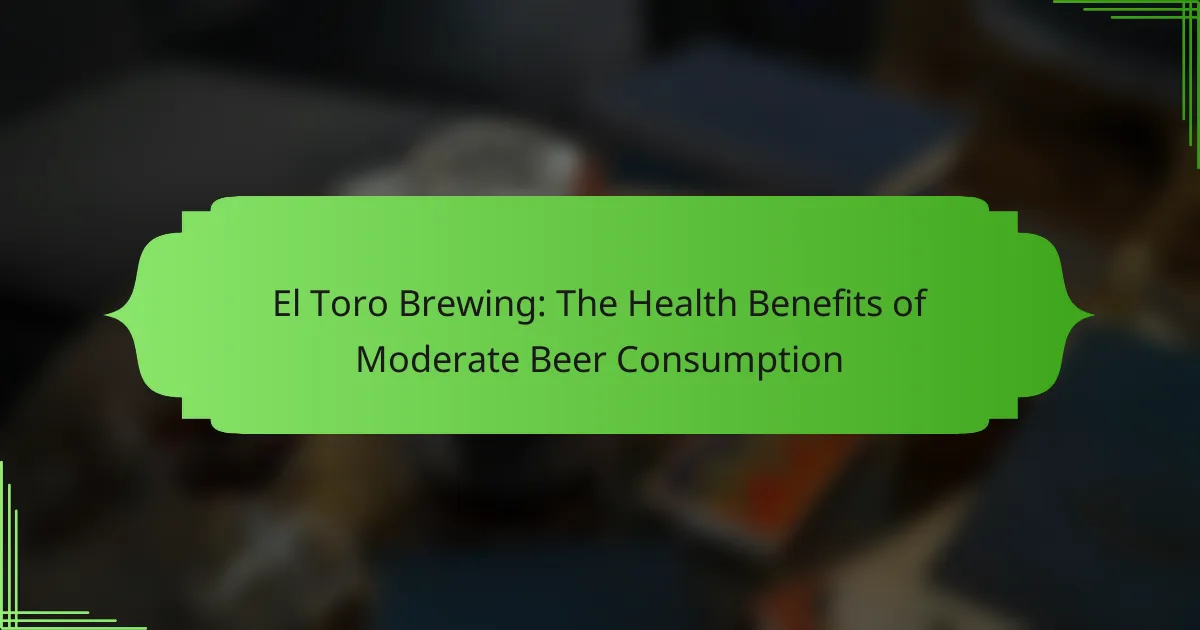El Toro Brewing is a craft brewery recognized for its innovative barrel aging techniques, which enhance the complexity and flavor profiles of its beers. The brewery utilizes a range of barrels, including those previously used for whiskey and wine, to impart unique characteristics such as oak, vanilla, and spice. The aging process involves careful monitoring of time, temperature, and humidity, allowing the beer to absorb compounds from the wood, resulting in a smoother mouthfeel and richer taste. This commitment to barrel aging distinguishes El Toro Brewing in the competitive craft beer market, offering consumers a diverse and rich flavor experience.

What is El Toro Brewing and its approach to barrel aging?
El Toro Brewing is a craft brewery known for its innovative approach to barrel aging. The brewery utilizes a variety of barrels, including those previously used for whiskey and wine. This method enhances the complexity and depth of their beers. El Toro Brewing carefully selects barrels to impart unique flavors. They experiment with aging times to achieve desired taste profiles. This approach contributes to a rich flavor experience for consumers. The brewery’s commitment to barrel aging distinguishes it in the craft beer market.
How does El Toro Brewing define barrel aging?
El Toro Brewing defines barrel aging as the process of maturing beer in wooden barrels. This method allows the beer to absorb flavors from the wood. It enhances the complexity and depth of the beer’s profile. The interaction between the beer and the barrel can impart notes of vanilla, oak, and other characteristics. This technique is also known to soften the beer’s bitterness. El Toro Brewing emphasizes that barrel aging is crucial for developing unique flavor profiles. The duration of aging can vary, affecting the final taste. Ultimately, barrel aging contributes significantly to the overall quality of the beer.
What types of barrels does El Toro Brewing use for aging?
El Toro Brewing uses a variety of barrels for aging. These include bourbon barrels, rum barrels, and wine barrels. Each type of barrel imparts distinct flavors to the beer. Bourbon barrels add notes of vanilla and oak. Rum barrels contribute sweetness and tropical fruit flavors. Wine barrels can enhance complexity with fruity and tannic characteristics. This diverse barrel selection plays a significant role in the brewing process. It allows El Toro Brewing to create unique and flavorful beers.
How does the choice of barrel influence the aging process?
The choice of barrel significantly influences the aging process of beverages like beer and whiskey. Different types of wood impart unique flavors and characteristics. For example, oak barrels are commonly used for their ability to add vanilla, caramel, and spice notes. The barrel’s previous contents also affect the aging. A barrel that previously held bourbon will impart different flavors than one used for wine. The size of the barrel plays a role too; smaller barrels have a higher surface area to volume ratio, leading to faster aging. Additionally, the char level inside the barrel affects the extraction of compounds. Lightly charred barrels may impart subtle flavors, while heavily charred barrels can add deeper, smokier notes. Temperature and humidity during aging also interact with the barrel choice, affecting the final flavor profile. Overall, the choice of barrel is crucial in shaping the complexity and depth of flavor in the final product.
What are the key benefits of barrel aging in brewing?
Barrel aging in brewing enhances flavor complexity and depth. This process allows beers to absorb characteristics from the wood, such as vanilla, oak, and spice notes. The interaction between beer and wood can also promote oxidation, which softens harsh flavors and adds smoothness. Additionally, barrel aging can introduce unique microbial activity, which contributes to sourness and funk in certain styles. This method can elevate the overall aroma and mouthfeel of the beer, making it more enjoyable. Historical evidence shows that barrel aging has been used for centuries, with many breweries now embracing this technique to create distinctive and high-quality brews.
How does barrel aging enhance flavor profiles in beers?
Barrel aging enhances flavor profiles in beers by allowing the beer to interact with the wood of the barrel. This interaction imparts various flavors such as vanilla, caramel, and oak. The process also allows for the extraction of tannins from the wood, which adds complexity and depth to the beer. Additionally, barrel aging can introduce subtle notes from previous contents, like whiskey or wine, enriching the flavor profile.
The environment inside the barrel promotes oxidation, which can soften harsh flavors and create a smoother mouthfeel. Research indicates that barrel aging can increase the complexity of beer flavors significantly. For example, a study published in the Journal of the American Society of Brewing Chemists found that barrel-aged beers exhibited a broader range of flavor compounds compared to non-barrel-aged counterparts.
What impact does barrel aging have on aroma and mouthfeel?
Barrel aging significantly enhances aroma and mouthfeel in beverages. The process allows compounds from the wood to infuse into the liquid. This infusion creates complex aromas, such as vanilla, caramel, and spice. The interaction between the beverage and the barrel also softens harsh flavors. This results in a smoother mouthfeel. Additionally, barrel aging can add a creamy texture. The duration of aging influences the intensity of these characteristics. Studies show that longer aging periods typically yield richer aromas and fuller mouthfeel.

How does the barrel aging process work at El Toro Brewing?
The barrel aging process at El Toro Brewing involves placing beer in wooden barrels for a specific duration. This method enhances the beer’s flavor profile and complexity. The barrels are typically sourced from various origins, such as bourbon or wine, which impart unique characteristics. During aging, the beer interacts with the wood, absorbing compounds like tannins and vanillin. This interaction contributes to flavors such as oak, vanilla, and spice. The temperature and humidity of the storage environment also play crucial roles in the aging process. Over time, the beer develops a smoother mouthfeel and richer taste. El Toro Brewing carefully monitors the aging process to achieve the desired flavor balance.
What steps are involved in the barrel aging process?
The barrel aging process involves several key steps. First, select the appropriate type of barrel, often made from oak. Next, clean and sanitize the barrel to prevent contamination. After that, fill the barrel with the liquid, such as beer or wine. Seal the barrel to minimize oxygen exposure. Then, store the barrel in a controlled environment to allow for aging. Monitor the aging process regularly to assess flavor development. Finally, when the desired flavor profile is achieved, transfer the liquid from the barrel for bottling or further processing. Each step is crucial for developing the unique flavors associated with barrel-aged beverages.
How does El Toro Brewing select the right beer for barrel aging?
El Toro Brewing selects the right beer for barrel aging based on specific flavor profiles and beer styles. They focus on robust beers that can withstand the aging process. Stouts and strong ales are often chosen for their rich flavors. The brewery evaluates the beer’s base characteristics, such as malt sweetness and hop bitterness. These attributes help determine how the beer will interact with the wood. Additionally, they consider the type of barrel used, as different woods impart distinct flavors. This careful selection process enhances the final product’s complexity. Ultimately, the goal is to create a harmonious balance between the beer and the barrel’s influence.
What is the typical duration of the barrel aging process at El Toro Brewing?
The typical duration of the barrel aging process at El Toro Brewing is between six months to two years. This timeframe allows the beer to develop complex flavors and aromas. During this period, the beer interacts with the wood of the barrels. The aging process enhances the overall character of the beer. El Toro Brewing employs various barrel types, which can influence the aging duration. The specific duration may vary depending on the beer style being aged. Each style can require different aging times to achieve optimal flavor profiles. This approach ensures that the final product meets the brewery’s quality standards.
What challenges does El Toro Brewing face during barrel aging?
El Toro Brewing faces several challenges during barrel aging. One significant challenge is the risk of oxidation. Exposure to oxygen can alter the flavor profile of the beer. Temperature fluctuations also pose a problem. These variations can affect the aging process and consistency of the final product. Additionally, barrel selection is crucial. Different wood types impart unique flavors, and choosing the wrong barrel can lead to undesirable outcomes.
Another challenge is contamination. Bacteria or wild yeast can spoil the beer if not properly managed. Monitoring the barrels for leaks is essential. Leaks can lead to evaporation and loss of volume. Finally, time management is critical. Barrel aging requires patience, and rushing the process can compromise flavor development. These challenges must be carefully navigated to produce high-quality barrel-aged beers.
How does evaporation affect the aging process?
Evaporation significantly impacts the aging process of beverages, especially in barrel aging. During barrel aging, a portion of the liquid evaporates, which is referred to as the “angel’s share.” This evaporation concentrates the flavors and aromas of the remaining liquid. As the volume decreases, the interaction between the liquid and the wood of the barrel increases. This interaction enhances the extraction of compounds from the wood, contributing to the complexity of flavor. Studies show that evaporation can lead to a more refined taste profile in aged beverages. The balance between evaporation and the aging environment is crucial for achieving desired flavor characteristics.
What measures does El Toro Brewing take to mitigate spoilage risks?
El Toro Brewing implements several measures to mitigate spoilage risks. They maintain strict temperature controls during fermentation and aging processes. This helps prevent unwanted microbial growth. The brewing facility is regularly sanitized to reduce contamination risks. El Toro Brewing also uses high-quality ingredients with low spoilage rates. They monitor pH levels to ensure optimal brewing conditions. Additionally, they package their products in airtight containers to limit exposure to oxygen. These practices collectively enhance the shelf life and quality of their brews.

What unique flavors emerge from El Toro Brewing’s barrel aging techniques?
El Toro Brewing’s barrel aging techniques produce unique flavors such as vanilla, oak, and caramel. These flavors result from the interaction between the beer and the wood of the barrels. The aging process allows the beer to absorb compounds from the wood. This absorption enhances the beer’s complexity and depth. Additionally, the type of barrel used influences the flavor profile. For example, bourbon barrels impart notes of spice and sweetness. In contrast, wine barrels can add fruity and floral characteristics. The duration of aging also affects flavor intensity. Longer aging periods typically yield richer and more pronounced flavors. These techniques contribute to El Toro Brewing’s distinctive offerings in the craft beer market.
How do different barrel types contribute to flavor diversity?
Different barrel types significantly contribute to flavor diversity in beverages like beer and whiskey. Each barrel type imparts unique characteristics based on its wood type, previous contents, and toasting or charring process. For instance, American oak barrels often add vanilla and coconut notes due to their lactone content. European oak barrels typically enhance flavors of dried fruit and spice, resulting from their tighter grain structure.
Additionally, barrels previously used for wine or spirits can influence flavor further. A bourbon barrel may add caramel and toffee notes, while a sherry cask can introduce rich, nutty flavors. The interaction between the beverage and the wood evolves over time, leading to a complex flavor profile.
Research shows that the toasting level of the barrel also affects flavor. Lightly toasted barrels may provide subtle flavors, while heavily charred barrels contribute deeper, smokier notes. This complexity in flavor is why different barrel types are essential in crafting diverse and rich tasting experiences.
What specific flavor notes are derived from whiskey barrels?
Whiskey barrels impart specific flavor notes such as vanilla, caramel, and oak. The toasting and charring process of the barrels enhances these flavors. Vanilla comes from the breakdown of lignin in the wood. Caramel notes develop from the caramelization of sugars during aging. Oak contributes a woody and sometimes spicy character. Other notes can include chocolate, dried fruit, and spices like cinnamon. These flavors evolve over time, influenced by the whiskey’s interaction with the wood. Research shows that the barrel’s previous contents also affect the final flavor profile.
What unique characteristics come from using wine barrels?
Using wine barrels imparts unique characteristics to beverages. These barrels contribute flavors such as vanilla, oak, and spice. The wood’s porous nature allows for micro-oxygenation. This process enhances the complexity and depth of the beverage. Additionally, the residual compounds from the wine can influence taste. Tannins from the wood can add structure. The aging process in wine barrels also smooths harsh flavors. Studies show that barrel aging can significantly impact overall flavor profiles.
What role does experimentation play in El Toro Brewing’s barrel aging?
Experimentation is crucial in El Toro Brewing’s barrel aging process. It allows brewers to explore various wood types and aging durations. Different barrels impart unique flavors and aromas to the beer. By testing these variables, El Toro can refine its recipes. This process helps achieve desired taste profiles. The brewery often documents outcomes to inform future batches. Such systematic experimentation enhances product consistency and quality. Ultimately, it fosters innovation in their brewing techniques.
How does El Toro Brewing innovate with barrel aging techniques?
El Toro Brewing innovates with barrel aging techniques by experimenting with diverse wood types and flavor profiles. They utilize barrels from various spirits, such as bourbon and rum, to impart unique characteristics. This approach allows them to create complex flavors in their beers. Additionally, they monitor aging times closely to achieve desired taste profiles. Their innovation also includes blending aged beers with fresh batches for balance. By incorporating local ingredients, they enhance the distinctiveness of each brew. This commitment to experimentation sets El Toro Brewing apart in the craft beer industry. Their techniques contribute to a dynamic flavor experience for consumers.
What are some notable experimental brews from El Toro Brewing?
El Toro Brewing is known for its innovative experimental brews. Notable examples include the “Barrel-Aged Imperial Stout.” This brew features rich flavors from oak aging. Another is the “Sour Cherry Ale,” which combines tart cherries with a sour base. The “Coffee Porter” is also significant, showcasing coffee infusion for a robust taste. El Toro Brewing emphasizes unique ingredients in these experimental offerings. These brews highlight the brewery’s commitment to flavor exploration and creativity.
What tips can home brewers learn from El Toro Brewing’s barrel aging practices?
Home brewers can learn several valuable tips from El Toro Brewing’s barrel aging practices. First, they should select high-quality barrels, as the wood type greatly influences flavor. El Toro emphasizes using barrels that previously held spirits or wine to enhance complexity. Second, monitoring the aging process is crucial. Regular sampling allows brewers to gauge flavor development. Third, understanding the impact of time is essential. Different beers benefit from varying aging durations. Fourth, temperature control during aging helps maintain consistency. El Toro maintains specific temperature ranges to optimize flavor extraction. Finally, experimenting with different barrel types can yield unique results. This diversity in approach can lead to innovative flavor profiles.
El Toro Brewing is a craft brewery recognized for its innovative barrel aging techniques that enhance the complexity and depth of its beers. The article explores how El Toro Brewing defines barrel aging, the types of barrels used, and the benefits of this process in brewing. It details the steps involved in barrel aging, the selection criteria for beers, and the challenges faced during the aging process. Additionally, the article highlights the unique flavors derived from different barrel types and the role of experimentation in creating distinctive brews. Home brewers can also glean valuable insights from El Toro Brewing’s practices to improve their own barrel aging techniques.


